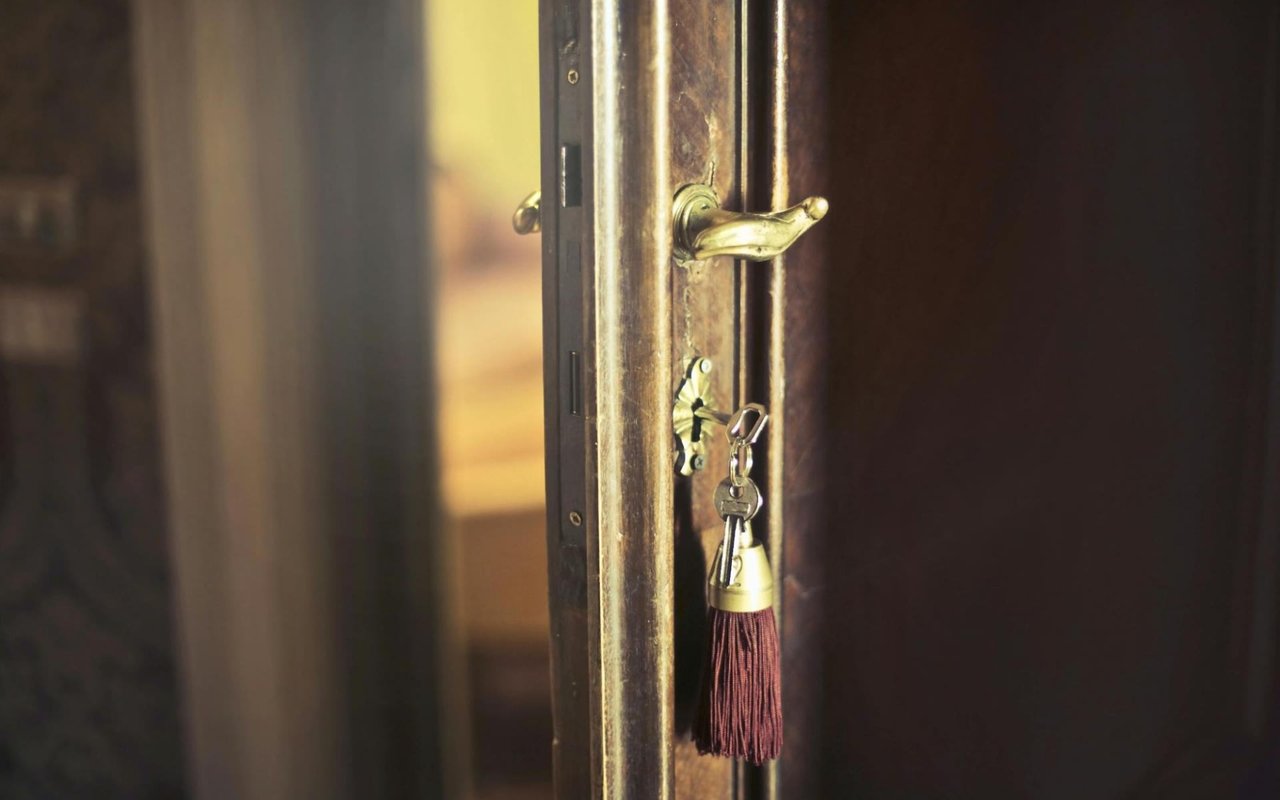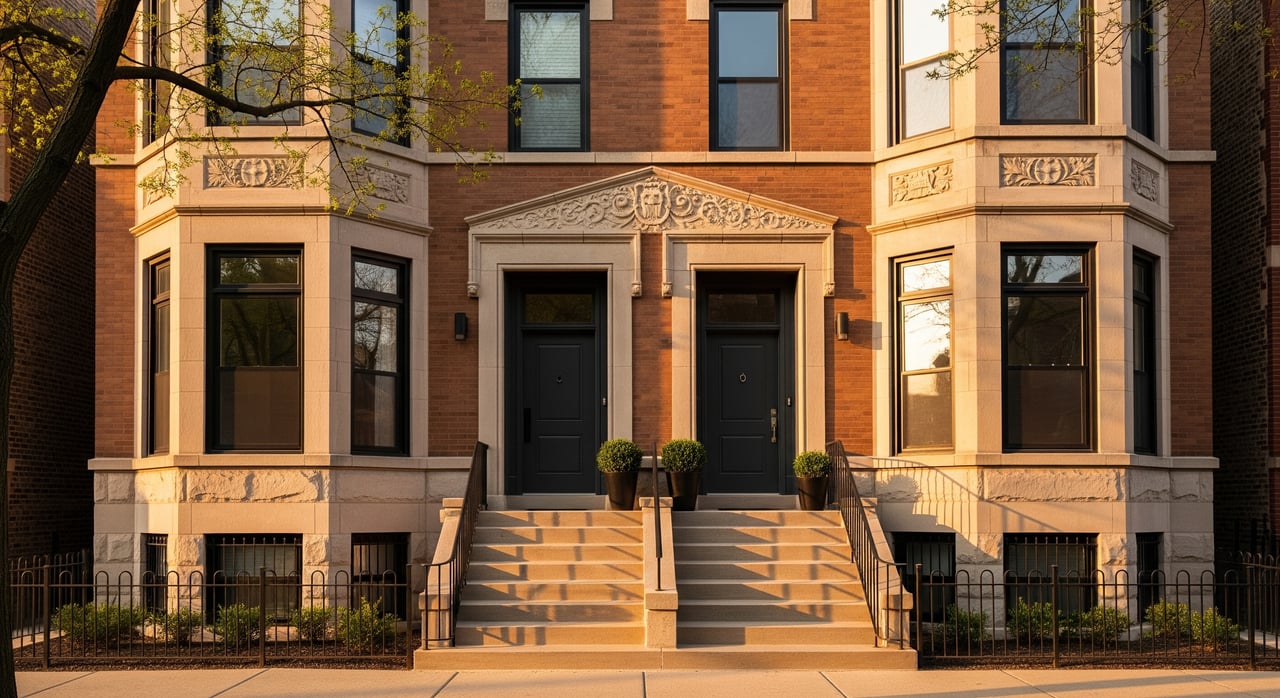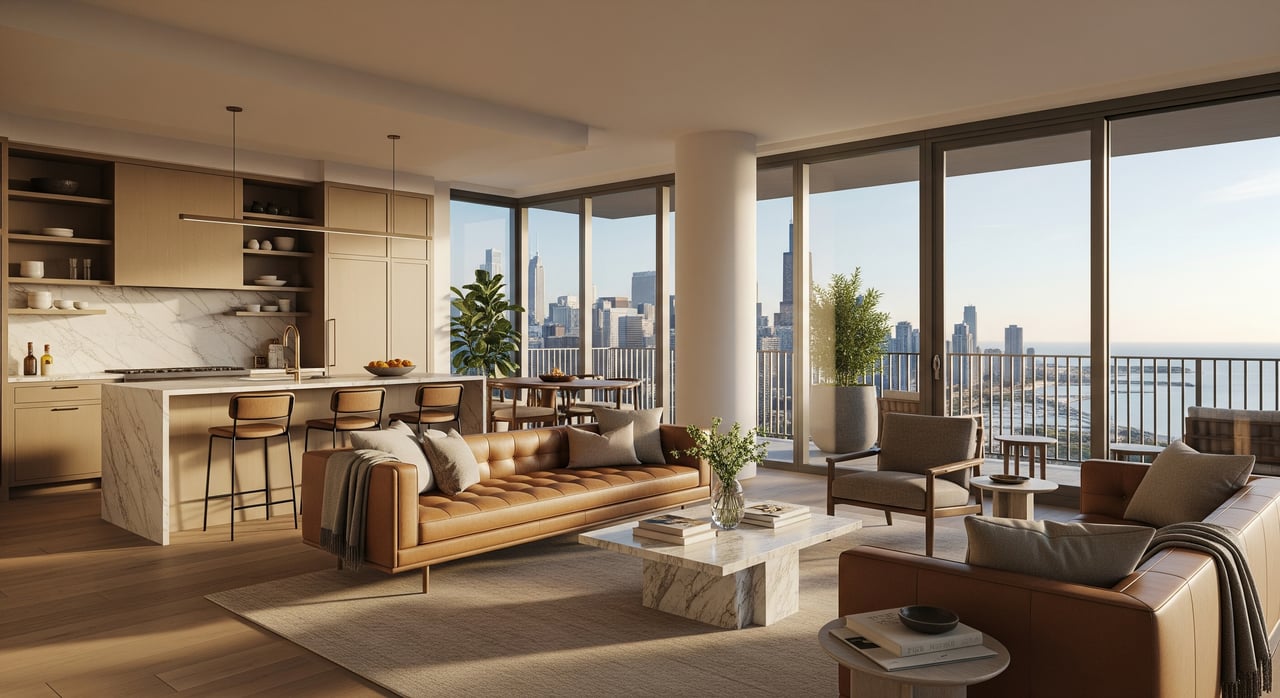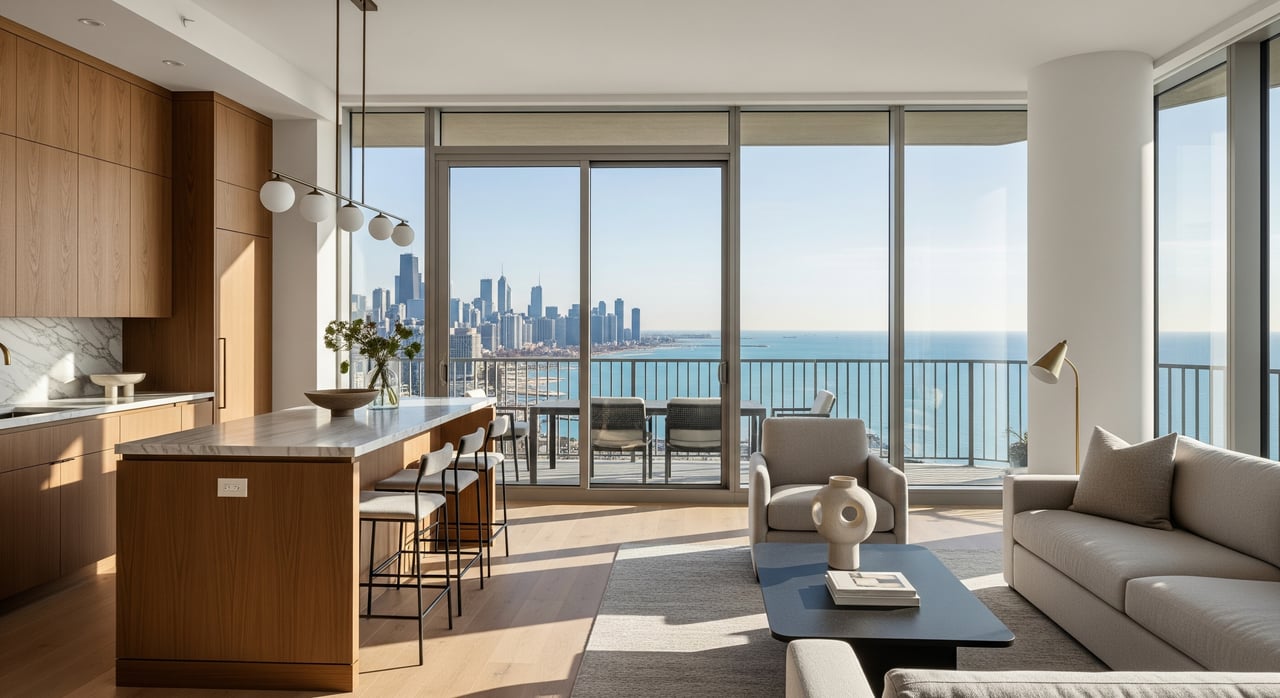Living in Lincoln Park, IL, is like stepping into a picturesque storybook where every page is filled with charm, elegance, and a sense of history. This prestigious neighborhood along Chicago's stunning lakefront offers residents an unparalleled blend of urban vibrancy and serene natural beauty. Imagine strolling through tree-lined streets that lead to the heart of the community — a magnificent, sprawling park that serves as the neighborhood's namesake. The park, with its lush greenery, tranquil ponds, and vibrant gardens, provides a perfect escape from city life.
Lincoln Park has a harmonious mix of historic architecture and modern residences. Victorian-era mansions stand proudly alongside sleek, contemporary homes. The architectural diversity adds to Lincoln Park's unique character, making it a truly enchanting place to live.
The Lincoln Park Conservatory
2391 N Stockton Dr, Chicago
The Lincoln Park Conservatory, constructed between 1890 and 1895, is a stunning example of Victorian architecture. Designed by the renowned architect Joseph Lyman Silsbee, the conservatory and botanical garden features a grand glass structure that houses an array of exotic plants. The intricate ironwork and lush interior create a captivating atmosphere. Within the conservatory, you'll find four distinct display houses, each with a different botanical experience. Outside the conservatory, the surrounding themed gardens, such as the Old English-style Grandmother's Garden and the Shakespeare Monument, provide additional historical and cultural charm.
The Lincoln Park Conservatory, constructed between 1890 and 1895, is a stunning example of Victorian architecture. Designed by the renowned architect Joseph Lyman Silsbee, the conservatory and botanical garden features a grand glass structure that houses an array of exotic plants. The intricate ironwork and lush interior create a captivating atmosphere. Within the conservatory, you'll find four distinct display houses, each with a different botanical experience. Outside the conservatory, the surrounding themed gardens, such as the Old English-style Grandmother's Garden and the Shakespeare Monument, provide additional historical and cultural charm.
The Alfred Caldwell Lily Pool
125 W Fullerton Pkwy, Chicago
The Alfred Caldwell Lily Pool, designed by Alfred Caldwell in the late 1930s, is a Prairie School landscape architecture masterpiece. Known as the "Rookery," this serene oasis features native plants, a tranquil lagoon, and a cascading waterfall designed to mimic a natural prairie river. Caldwell's work is celebrated for its seamless integration of natural elements and architectural design, creating a harmonious and peaceful environment. Open seasonally, the Lily Pool is a perfect escape for nature lovers and a beautiful spot to unwind. The thoughtful design invites visitors to wander along its paths, soaking in the sights and sounds of this natural retreat.
The Alfred Caldwell Lily Pool, designed by Alfred Caldwell in the late 1930s, is a Prairie School landscape architecture masterpiece. Known as the "Rookery," this serene oasis features native plants, a tranquil lagoon, and a cascading waterfall designed to mimic a natural prairie river. Caldwell's work is celebrated for its seamless integration of natural elements and architectural design, creating a harmonious and peaceful environment. Open seasonally, the Lily Pool is a perfect escape for nature lovers and a beautiful spot to unwind. The thoughtful design invites visitors to wander along its paths, soaking in the sights and sounds of this natural retreat.
St. James Lutheran Church
2050 N Fremont St, Chicago
St. James Lutheran Church, constructed in 1870, is a striking example of Gothic Revival architecture that has become a prominent feature in Lincoln Park's architectural landscape. The church's towering spire and pointed arches draw the eye upward, creating a sense of awe and reverence. The detailed stonework on the exterior is a testament to the era's craftsmanship, showcasing intricate designs that have stood the test of time. Inside, beautiful stained-glass windows fill the church with colorful light, while intricate woodwork adds to the overall elegance and warmth of the interior.
St. James Lutheran Church, constructed in 1870, is a striking example of Gothic Revival architecture that has become a prominent feature in Lincoln Park's architectural landscape. The church's towering spire and pointed arches draw the eye upward, creating a sense of awe and reverence. The detailed stonework on the exterior is a testament to the era's craftsmanship, showcasing intricate designs that have stood the test of time. Inside, beautiful stained-glass windows fill the church with colorful light, while intricate woodwork adds to the overall elegance and warmth of the interior.
The Old Town Triangle Historic District
1763 N. North Park Ave, Chicago
The Old Town Triangle Historic District is a cherished part of the greater Lincoln Park neighborhood, celebrated for its collection of Victorian-era buildings. This historic district offers a fascinating journey through time, with well-preserved examples of Italianate, Queen Anne, and Second Empire architectural styles. One of the standout features of the district is an original small frame worker-style Cottage from the 1850s, providing a rare glimpse into the pre-Civil War era. The narrow streets and historic homes create a picturesque, timeless atmosphere that feels worlds away from modern city life. Strolling through the Old Town Triangle, residents and visitors alike can appreciate the craftsmanship and architectural diversity that make this area unique.
The Old Town Triangle Historic District is a cherished part of the greater Lincoln Park neighborhood, celebrated for its collection of Victorian-era buildings. This historic district offers a fascinating journey through time, with well-preserved examples of Italianate, Queen Anne, and Second Empire architectural styles. One of the standout features of the district is an original small frame worker-style Cottage from the 1850s, providing a rare glimpse into the pre-Civil War era. The narrow streets and historic homes create a picturesque, timeless atmosphere that feels worlds away from modern city life. Strolling through the Old Town Triangle, residents and visitors alike can appreciate the craftsmanship and architectural diversity that make this area unique.
The McCormick Row House District
800 W Chalmers Pl, Chicago
The McCormick Row House District is a remarkable series of row houses built in the 1880s. These homes were commissioned by the influential industrialist Cyrus McCormick and are notable for their uniform Italianate design. This architectural style, popular in the late 19th century, is characterized by elegant arched windows, ornate cornices, and distinctive red brick facades. Walking through this district, one can easily imagine the opulent lifestyle of its original residents, who were among the wealthiest in Chicago at the time. The McCormick Row House District showcases the refined tastes and prosperity of the Gilded Age.
The McCormick Row House District is a remarkable series of row houses built in the 1880s. These homes were commissioned by the influential industrialist Cyrus McCormick and are notable for their uniform Italianate design. This architectural style, popular in the late 19th century, is characterized by elegant arched windows, ornate cornices, and distinctive red brick facades. Walking through this district, one can easily imagine the opulent lifestyle of its original residents, who were among the wealthiest in Chicago at the time. The McCormick Row House District showcases the refined tastes and prosperity of the Gilded Age.
The DePaul University Campus
2250 N Sheffield Ave, Chicago
DePaul University's Lincoln Park campus is a captivating blend of historic and contemporary architectural styles, reflecting the institution's long-standing presence in the community. Among its notable structures is the Gothic Revival-style McGaw Hall, which exudes a timeless elegance with its pointed arches and intricate stonework. This historic building stands in striking contrast to the modernist Schmitt Academic Center, a testament to the evolving architectural landscape of the campus. The seamless integration of old and new on DePaul's campus creates a dynamic environment that honors tradition while embracing innovation. This unique architectural juxtaposition not only enhances the aesthetic appeal of the university but also underscores its commitment to providing a stimulating educational experience.
DePaul University's Lincoln Park campus is a captivating blend of historic and contemporary architectural styles, reflecting the institution's long-standing presence in the community. Among its notable structures is the Gothic Revival-style McGaw Hall, which exudes a timeless elegance with its pointed arches and intricate stonework. This historic building stands in striking contrast to the modernist Schmitt Academic Center, a testament to the evolving architectural landscape of the campus. The seamless integration of old and new on DePaul's campus creates a dynamic environment that honors tradition while embracing innovation. This unique architectural juxtaposition not only enhances the aesthetic appeal of the university but also underscores its commitment to providing a stimulating educational experience.
The Lincoln Park Zoo
Chicago, IL
Spanning 35 acres, the Lincoln Park Zoo is a beloved attraction and a site of historical significance as the fourth oldest zoo in North America. Among its many features are several historic buildings. Notably, the Kovler Lion House, built in 1912, and the Primate House, constructed in 1927, exemplify the grandeur of the Beaux-Arts architectural style. These buildings boast grand facades and classical details, which elevate the aesthetic appeal of the zoo.
The Kovler Lion House, with its impressive stone lions and majestic entrance, provides a dignified home for its inhabitants. The Primate House's intricate design and large windows create an engaging space for the animals and visitors. The Lincoln Park Zoo Buildings are a testament to the zoo's long-standing commitment to combining conservation with architectural beauty.
Spanning 35 acres, the Lincoln Park Zoo is a beloved attraction and a site of historical significance as the fourth oldest zoo in North America. Among its many features are several historic buildings. Notably, the Kovler Lion House, built in 1912, and the Primate House, constructed in 1927, exemplify the grandeur of the Beaux-Arts architectural style. These buildings boast grand facades and classical details, which elevate the aesthetic appeal of the zoo.
The Kovler Lion House, with its impressive stone lions and majestic entrance, provides a dignified home for its inhabitants. The Primate House's intricate design and large windows create an engaging space for the animals and visitors. The Lincoln Park Zoo Buildings are a testament to the zoo's long-standing commitment to combining conservation with architectural beauty.
The Chicago History Museum
1601 N Clark St, Chicago
The Chicago History Museum, founded in 1856, is in a striking Georgian Revival building designed by the esteemed architectural firm Graham, Anderson, Probst & White. This elegant structure, with its symmetrical design and classic details, provides a fitting home for an institution dedicated to preserving and sharing the rich history of Chicago.
The museum's architecture is symbolic of its mission. The grand entrance and refined aesthetic invite visitors to explore the vast collections and exhibits that tell the story of Chicago's past. Inside, the museum has artifacts, photographs, and interactive displays that bring the city's history to life. With its dignified presence, the building enhances the experience, creating a sense of reverence and curiosity.
The Chicago History Museum, founded in 1856, is in a striking Georgian Revival building designed by the esteemed architectural firm Graham, Anderson, Probst & White. This elegant structure, with its symmetrical design and classic details, provides a fitting home for an institution dedicated to preserving and sharing the rich history of Chicago.
The museum's architecture is symbolic of its mission. The grand entrance and refined aesthetic invite visitors to explore the vast collections and exhibits that tell the story of Chicago's past. Inside, the museum has artifacts, photographs, and interactive displays that bring the city's history to life. With its dignified presence, the building enhances the experience, creating a sense of reverence and curiosity.
Embrace the charm of Lincoln Park
Living in Lincoln Park means being surrounded by a rich tapestry of architectural beauty, historic landmarks, and vibrant community life. When it comes to finding your dream home in this delightful area, the real estate agents of Niko Collaborative are here to guide you. They empower their clients by leveraging real estate to enhance their lives and seize new opportunities. With their expert knowledge and personalized approach, Niko Collaborative ensures that your journey to owning a piece of Lincoln Park real estate is as enjoyable as the neighborhood.




